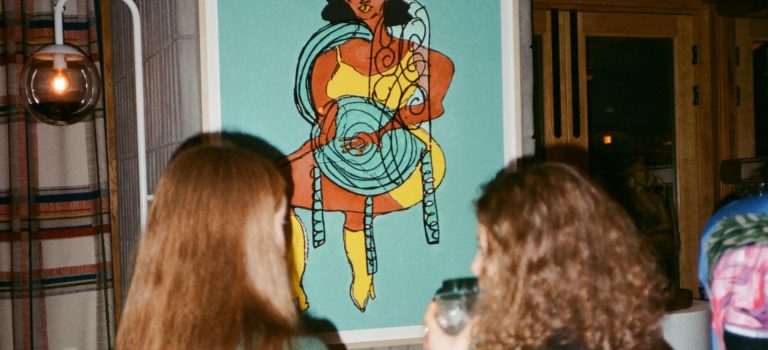Source: Vogue Business.
The article explores how platforms aimed at younger, first-time collectors (especially Gen Z) are designing their offers an looks at how market players are adapting to Gen Z’s preferences.
In 2015, childhood friends Christian Luiten and Curtis Penning set up a blog inspired by their love of contemporary art, which they had discovered through rap music. The pair had grown up in a small Dutch city without access to galleries and museums, and were looking for a way to connect with fellow culture fans. The blog featured album covers, rap lyrics and cool contemporary art. Named Avant Arte, it grew into a platform for discovering artists, attracting a community of over 3.5 million people across more than 100 countries.
Today, Avant Arte is considered one of the art market’s most influential platforms bringing the next generation into the art world — serving as a jumping-off point for first-time collectors, particularly those who are young or feel intimidated by the art world.
“What we hear a lot is, ‘I just don’t know where to start.’ They might have the money and definitely have the taste, but it just doesn’t feel accessible to them,” says Mazdak Sanii, who met Luiten and Penning while he was working at online music broadcaster and club promoter Boiler Room, and joined them as a founder, becoming CEO in 2018.
Like luxury, the global art market is contracting: sales declined 12 per cent last year, according to the 2025 Art Basel and UBS Art Market Report. Despite the drop in overall value, the number of transactions taking place increased 3 per cent; unlike luxury, in art, the drag is at the higher end, while there’s much more growth among lower price points. Against this backdrop, the art market is hoping to court the next generation of collectors — and Avant Arte’s approach is resonating.
The business reached $23 million in sales in 2024, partly thanks to its collaborations with contemporary artists, which are set at affordable prices (between €350 and €1,500), based on factors like the artist’s positioning, production methods and the scope of the potential audience. “Young collectors are more focused on a narrower group of their favourite artists and the mediums those artists are known for. They’re looking for price points where they can still connect with quality, but on a more affordable level,” says Sanii.
Making art accessible for the next generation
The downturn in the art market has made younger collectors more selective and discerning. “New buyers and collectors are entering the [art] market through different avenues than their predecessors, with an appetite for first-class, multi-dimensional cultural experiences,” says Vincenzo de Bellis, chief artistic officer and global director of Art Basel Fairs. In response, global art fair series Art Basel has adapted by adding formats like its Art Basel Awards and the Art Basel Shop to provide further touchpoints for the younger generation.
De Bellis has noticed a push towards accessibility, inclusivity and education among the more youthful art collectors. “This generation expects transparency and meaningful engagement — not just a transaction, but a relationship with galleries, institutions and artists,” he says. “Far from diluting value, these efforts build trust and cultivate long-term engagement with the next generation of collectors.”
Avant Arte has been able to capitalise on this trend with its artist editions. “Younger audiences care about the involvement of artists, so we make sure the piece reflects the artist’s work properly. In our storytelling campaigns, it’s about how we create a connection between the artists and the work, having the artists explain why they wanted to do this project, why they wanted to reach new audiences, talk about this piece they wanted to make into an edition,” says Sanii. There’s even content about the craft of printmaking, along with footage from the printmaking studio.
Avant Arte’s artist editions are limited — either by quantity or to a particular buying window. In both instances, the aim is to maintain the value of the piece. “There’s always a tension between inherently limited work and the mission of accessibility,” says Sanii. “The time-limited model is valuable because it gives totally fair access in a window of time.”
Graduating beyond entry level
But the big question facing both luxury and art is, how do you convert entry-level buyers into bigger spenders?
In the art market, platforms are increasingly prioritising engagement with those early in their collector journeys, to help secure their patronage in the future. “Younger collectors who begin learning about and investing time into artists early on, consistently become the prominent collectors of tomorrow and speak about how meaningful their relationships are with artists, dealers and other art world participants,” says Matthew Newton, senior art advisory specialist at UBS Global Wealth Management.
At Avant Arte, strong customer service and storytelling have been essential to nurturing that patronage — especially after the point of purchase. “You’re charmed up until the point where you buy something, then after the order confirmation, people are left in the desert,” says Sanii. “That’s where there’s the most opportunity to make them feel special, by thanking them for their support of the museum, explaining the impact and inviting them to preview.” He adds that the organisation has also looked at improving the packaging, framing, hanging and shipping processes — all typical pain points for collectors.
Experts also agree that young collectors are particularly driven by their values. “Younger buyers place a premium on alignment with their values and are motivated by discovering artists whose works resonate with the social and cultural issues that matter to them,” says Art Basel’s de Bellis.
While only 3 per cent of traditional buyers see art collection as a means of philanthropy, more than half of the new generation do, according to Avant Arte’s Collector report, and almost 90 per cent of new-gen collectors have the means and the desire to donate more to museums. “Younger people may not want their name on a building, but they do care about these institutions and see them as playing a pivotal role in culture and society,” says Sanii. Avant Arte has been able to respond to this by developing a public art programme where it places works by leading artists in public spaces, increasing accessibility, and a museum programme to fund art institutions with the goal of creating new patrons for the arts. Luxury could apply a similar approach by deepening its cultural and philanthropic framing — though the first step for that to be credible would be improving ethics across the supply chain.
Whether in fashion or art, the players who resonate with the younger generation will be able to translate these values for the modern world. “Like our inherent desire to look good, humans have this curious and insatiable appetite to live with beautiful and interesting things. We are also driven to collect things that others might not have,” says Newton. “There will always be a group of people seeking access to rare and interesting objects that capture the spirit of our time. The most successful participants in the art world recognise this and find sustainable ways to focus on top-tier quality artists whose works are relevant historically while speaking to our contemporary moment.”








